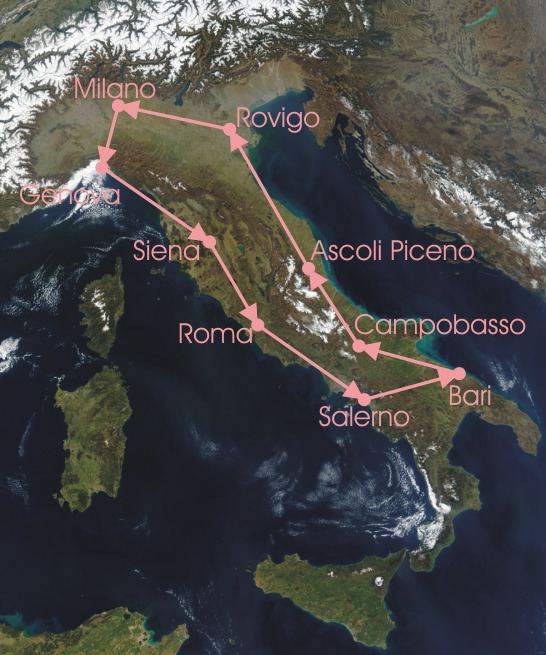Dates 6 – 22 May Distance 2,932 km (1,822 mi) | Stages 9 Winning time 135h 15' 56" | |
 | ||
The 1913 Giro d'Italia was the 5th edition of the Giro d'Italia, a cycling race organized and sponsored by the newspaper La Gazzetta dello Sport. The race began on 6 May in Milan with a stage that stretched 341 km (212 mi) to Genoa, finishing back in Milan on 22 May after a 321.1 km (200 mi) stage and a total distance covered of 2,932 km (1,822 mi). The race was won by the Italian rider Carlo Oriani of the Maino team. Second and third respectively were the Italian riders Eberardo Pavesi and Giuseppe Azzini.
Contents
It was the last Giro with a final classification in points and the first one in which the final winner of the race did not win a single stage. The Giro saw the debut of the twenty-year-old Costante Girardengo, who won the 6th stage. The 1913 Giro was the last concluded by Luigi Ganna, winner of the first edition.
Changes from the 1912 Giro d'Italia
Outside the yearly changes in the route, race length, and number of stages, the biggest change to the how the general classification was to be calculated. The race organizers decided to change back to the way the general classification had been calculated in the earlier editions, by the individual and the awarding of points based on how high the rider placed in each stage rather than doing a team points based system like the previous edition.
Participants
Of the 99 riders that began the Giro d'Italia on 6 May, 35 of them made it to the finish in Milan on 22 May. Riders were allowed to ride on their own or as a member of a team. There were eight teams that competed in the race: Ganna-Dunlop, Gerbi-Dunlop, Globo-Dunlop, Legnano-Dunlop, Maino-Pirelli, Otav-Pirelli, Peugeot Italy-Tedeschi, and Stucchi-Dunlop.
The peloton was composed completely of Italians. The field featured three former Giro d'Italia champions in the 1909 winner Luigi Ganna, three-time winner and returning champion Carlo Galetti, and returning champion Eberardo Pavesi. Other notable Italian riders that started the race included Giovanni Rossignoli, Alfredo Sivocci, Carlo Oriani, and Giuseppe Azzini.
General classification
There were 35 cyclists who had completed all nine stages. For these cyclists, the points they received from each of their stage placing's were added up for the general classification. The cyclist with the least accumulated points was the winner.
Team classification
To be eligible for the team classification, known in Italian as the Premio dell'Industria, the team must have three riders complete the course. For each team that had at least the necessary three riders complete the race, the three riders with the lowest point totals from the team would be added together to give each team its score. The team with the lowest total of points was the winner of the classification.
